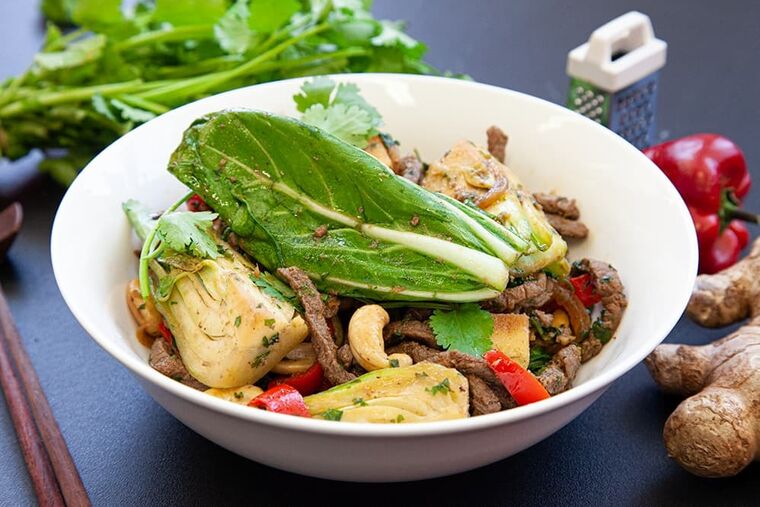Take Sandra’s tip and marinate the beef overnight, and whipping up this iron-rich stir fry after work will be a breeze.
- L/D Lunch/Dinner
- DF Dairy free
- GF Gluten free
- IR Iron-rich
- Prep time 30 mins
- Cook Time 10 mins
- Serves 4
- Difficulty easy

Method
- First, make the marinade. Crush or finely chop garlic. If using chili, thinly slice it, removing the seeds if less heat is desired. Peel and finely grate ginger. Put ½ garlic, ½ ginger, mirin, tamari and honey (and chili, if using) in a large bowl.
- Whisk to combine. Separate beef strips, add to the marinade and toss to coat. Marinate for 20 minutes prior to cooking (I marinate overnight so it's ready to go when I get home from work).
- Thinly slice onion. Thinly slice capsicums, discarding seeds. Trim and cut bok choy/pak choy into thirds, keeping leaves and stems separate. Finely chop coriander, including stems.
- Heat about 3 tsp oil in a wok or large deep frypan over high heat. Remove beef from marinade, reserving the marinade. Stir-fry the beef, in two batches, for 2-3 minutes until browned. Remove from the pan and wipe the pan clean.
- Heat about 2 tsp oil in the pan over high heat. Stir-fry the onion, remaining garlic and ginger and capsicum for 1-2 minutes, stirring constantly to prevent the garlic and ginger from sticking (adding 1-2 tsp of water will help avoid this) until it starts to soften.
- Add the bok/pak choy stems (they take longer to cook than the leaves), stir-fry for 1-2 minutes. Add the bok/pak choy leaves, reserved marinade (and cooked beef juices), stir-fry to combine flavours.
- Return beef to pan, stir in cashews and half the coriander. Divide stir fry among bowls. Garnish with remaining coriander to serve.
Nutritional information
By Jean Hailes naturopath and herbalist Sandra Villella
Lean red meat is one of the best and most well-absorbed sources of iron. Women are more prone to low iron due to the blood loss during menstrual periods. Women with heavy menstrual bleeding are more at risk.
In August 2019, the Heart Foundation of Australia introduced a recommended limit of less than 350 grams of red meat per week; beef stir-fry was actually one of the recommendations from the Chief Medical Adviser, cardiologist Professor Garry Jennings.
This recipe serves four, so at 125g of red meat per serve, it follows the guidelines nicely, allowing for another red meat serving for the week. The cashews enhance the overall protein content, but from a plant source, and the Heart Foundation encourages a greater emphasis on plant sources of protein.
This recipe also contains green leafy vegetable (bok choy/pak choy), which is a plant source of iron. The iron in vegetables is less well absorbed by the body, but when combined with an animal source, or a food containing vitamin C – such as capsicum – the iron absorption is enhanced. A big bunch of coriander also is a green leafy vegetable.
The Chinese greens belong to the brassica family, and there is some evidence to show that regularly eating vegetables from this family is associated with a reduced risk of some cancers, including colon (bowel) cancer and breast cancer.
Ginger, which contributes to this recipe's fragrant taste, is a warming herb traditionally used for its anti-spasmodic and anti-inflammatory action in helping to reduce period pain. In medicinal doses, it is thought to work similarly to antiinflammatories used for pain.
This is a low-GI meal of lean protein and low carbohydrate vegetables, making it ideal for women with polycystic ovarian syndrome (PCOS), for who a low-GI diet can help in managing blood glucose and insulin resistance, and maintaining a healthy weight.
Brimming with the natural flavours of herbs and spices, this makes for an easy balanced meal to add to your regular recipes.




